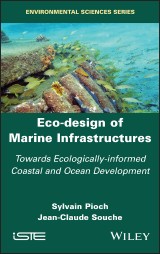Details

Eco-design of Marine Infrastructures
Towards Ecologically-informed Coastal and Ocean Development1. Aufl.
|
139,99 € |
|
| Verlag: | Wiley |
| Format: | |
| Veröffentl.: | 13.09.2021 |
| ISBN/EAN: | 9781119865933 |
| Sprache: | englisch |
| Anzahl Seiten: | 288 |
DRM-geschütztes eBook, Sie benötigen z.B. Adobe Digital Editions und eine Adobe ID zum Lesen.
Beschreibungen
This book offers an insight into how to create aesthetically pleasing, environmentally integrated, multi-functional developments in the ocean or on the coastline.<br /><br />Eco-design of Marine Infrastructures provides practical and realistic solutions for delivering projects that strive to minimize negative environmental impacts.<br /><br />Using case studies and examples, this book presents a toolkit of options, allowing decision makers and planners to see what is possible and to make informed choices about the risks and benefits of eco-design. It is intended for researchers, engineers, students and decision makers, or anyone who is curious to see how nature can be integrated into development.
<p>Foreword ix</p> <p>Preface xi</p> <p>Acknowledgments xv</p> <p><b>Chapter 1. Principles and Genesis of Maritime Eco-design </b><b>1 </b></p> <p>1.1. Principles of maritime eco-design 2</p> <p>1.2. Definition of eco-design of marine infrastructures 4</p> <p>1.3. Japanese inspiration 8</p> <p>1.3.1. Influence of the Japanese vision for sea-friendly development projects 8</p> <p>1.3.2. The Japanese <i>Sato-umi </i>10</p> <p>1.3.3. Artificial marine habitats: Japanese origin of inspiration for eco-design 11</p> <p>1.4. Assessing the effects of a project on the environment: the impact study 12</p> <p>1.4.1. Designing a better project for the environment 14</p> <p>1.4.2. Informing the administrative authority on the decision to be taken 14</p> <p>1.5. The “no net loss of biodiversity” objective: a regulatory obligation for developers, an opportunity for eco-design 17</p> <p>1.6. Specificities of the environmental assessment related to the marine environment: the “natural” public maritime domain concept 19</p> <p>1.6.1. The natural public maritime domain, an essential concept 19</p> <p>1.6.2. Managing the marine environment: a necessarily integrated approach 23</p> <p><b>Chapter 2. Maritime Civil Engineering </b><b>27</b></p> <p>2.1. General information 28</p> <p>2.2. Typology of coastlines 30</p> <p>2.2.1. Coastal classification and sea-level evolution 30</p> <p>2.2.2. Sea-level fluctuations and coastline erosion 33</p> <p>2.2.3. Rocky shores 35</p> <p>2.2.4. Soft coastlines 36</p> <p>2.2.5. Fine material shorelines 38</p> <p>2.2.6. Coral bioconstructed coastlines and mangroves 39</p> <p>2.2.7. Assessment 41</p> <p>2.3. Coastal defense works 41</p> <p>2.3.1. Main transverse structures: groins and jetties 42</p> <p>2.3.2. Main longitudinal structures: breakwaters and upper beach structures 43</p> <p>2.4. Port structures 47</p> <p>2.4.1. Criteria for establishing a port 47</p> <p>2.4.2. Geographical location 48</p> <p>2.4.3. Economic criteria 49</p> <p>2.4.4. Operating principles of ports 51</p> <p>2.4.5. Typology of port structures 56</p> <p>2.5. Design approach 59</p> <p>2.5.1. The design methodology 59</p> <p>2.5.2. Ocean data 62</p> <p>2.5.3. Service actions 70</p> <p>2.5.4. The usual design criteria 73</p> <p>2.5.5. Geotechnical data 74</p> <p>2.5.6. Data on construction materials 79</p> <p>2.5.7. Synthesis 87</p> <p><b>Chapter 3. Eco-design of Marine Infrastructures</b><b> 89</b></p> <p>3.1. The evolution of research work towards the eco-design of marine structures 90</p> <p>3.2. The modernized approach to project management 96</p> <p>3.2.1. Eco-design actors 101</p> <p>3.2.2. Development and maturation of an eco-designed development project 103</p> <p>3.3. The methodological approach to eco-design: responding to the expressed need 109</p> <p>3.3.1. Eco-design, an adapted technical response for engineers and project managers 110</p> <p>3.3.2. Eco-design as a lever for modernizing the execution of works 117</p> <p>3.3.3. Monitoring, control, validation and satisfaction for the user and nature 121</p> <p>3.4. Infrastructure as a new support for marine life 122</p> <p>3.4.1. Biophysical data of the environment 123</p> <p>3.4.2. Integration of the infrastructure into an ecosystem 130</p> <p>3.4.3. Bio-inspiration and design of eco-designed structures 144</p> <p>3.5. Eco-design at the material level: the example of concrete 144</p> <p>3.5.1. A little history 144</p> <p>3.5.2. Concrete, the state of the art 150</p> <p>3.5.3. Concrete formulations 156</p> <p>3.5.4. The integrative eco-design of the performance approach: perspectives 159</p> <p><b>Chapter 4. Evidence Through Experience: Examples of Eco-designed Marine Projects </b><b>163</b></p> <p>4.1. Mayotte submarine pipeline: an initial eco-designed marine structure 167</p> <p>4.2. Bio-inspiration and nature-based solutions for artificial reef design 177</p> <p>4.2.1. The value of creating artificial habitats 178</p> <p>4.2.2. The issue of fish habitat creation 179</p> <p>4.3. The scope of port eco-design 183</p> <p>4.3.1. The concept of port eco-design 183</p> <p>4.3.2. Eco-design of the port of Guilvinec-Lechiagat 185</p> <p>4.3.3. Ecological structures designed as natural grass beds 186</p> <p>4.3.4. “Calais Port 2015” port project 187</p> <p>4.4. Eco-design for coastal protection 191</p> <p>4.4.1. Beneficial use of coastal sediment transport: the Sand Motor project 192</p> <p>4.4.2. The experience of the ECOncrete company 194</p> <p>4.4.3. Landscape redevelopment of the East Darling Harbour waterfront in Sydney 196</p> <p>4.4.4. CLI’s experience with concrete dike shells: the need for eco-design 198</p> <p>4.4.5. Eco-design of the Brest harbor breakwater 200</p> <p>4.5. Biomimetic artificial reefs in Corsica (Ajaccio) 202</p> <p>4.6. Artificial island eco-design 208</p> <p>4.6.1. The Monegasque government’s vision for the Principality of Monaco’s offshore extension 208</p> <p>4.6.2. The genesis of the eco-design of the Monegasque artificial peninsula project 214</p> <p>4.7. Eco-design of mooring systems 216</p> <p>4.7.1. Eco-design of moorings for recreational vessels in Guadeloupe 217</p> <p>4.7.2. Eco-design of moorings for large vessels and yachts as a solution for the protection of the Mediterranean Posidonia meadow 225</p> <p>4.8. Eco-design of offshore viaduct piles 232</p> <p>4.9. Offshore wind farm project eco-design: multi-use perspectives 236</p> <p>Conclusion 239</p> <p>References 243</p> <p>Index 259</p>
<p><b>Sylvain Pioch</b> holds a PhD in Geography and Planning, is an Ecological Engineer (AFIE) and a Senior Lecturer at Paul Valéry University, Montpellier 3, France. He works on the assessment of the impacts of coastal developments, eco-design and ecological maritime restoration.</p> <p><b>Jean-Claude Souche</b> holds a PhD and is a civil engineer. As well as being a teacher-researcher, he is also Head of the Civil Engineering and Sustainable Building department at IMT Mines Alès, France. He is a specialist in port and coastal civil engineering, and in the eco-design of maritime works and their interactions with their environment.</p>

















